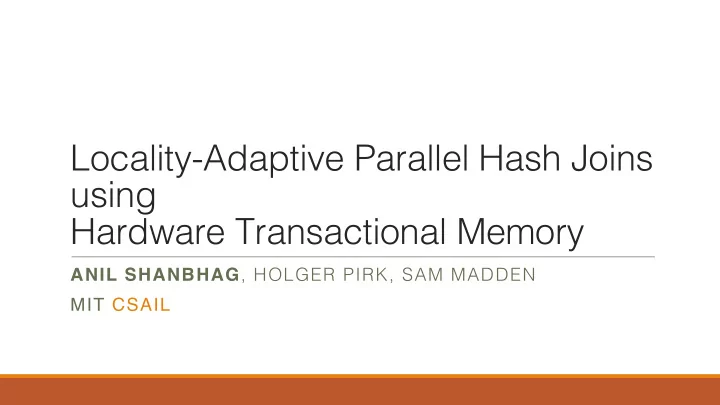

Locality-Adaptive Parallel Hash Joins using Hardware Transactional Memory ANIL SHANBHAG , HOLGER PIRK, SAM MADDEN MIT CSAIL
History of Parallel Hash Joins Shared Hash Table Radix Partitioning based Join based Join Pictures from “Main-Memory Hash Joins on Multi-Core CPUs: Tuning to the Underlying Hardware” Balkesen et al. 2 MIT CSAIL
Motivation Data can have spatial locality May arise because of : ◦ Periodic bulk updates => Locality in date and correlated attributes ◦ Trickle loading in OLTP systems => Locality in date ◦ Automatically assigned IDs => monotonically increasing counters From “Column Imprints: A Secondary Index Structure” Sidirourgos et. al, SIGMOD 13 3 MIT CSAIL
Motivation Simple experiment: Compare the time of hash building phase of 3 approaches: ◦ Global hash table using atomics (Atomic) ◦ Parallel Radix Join (PRJ) ◦ Global hash table with no conc. Control (NoCC) NoCC is incorrect; existing approaches are > 3x slower than it. 4 MIT CSAIL
Can we do as good as NoCC ? Yes we can ! Rest of this talk: ◦ Using HTM to achieve better performance ◦ Making HTM-based hash join self-tuning ◦ Adaptively fall back to Radix Join 5 MIT CSAIL
Hardware Transactional Memory Sequence of instructions with ACI(D) properties Balance Transfer { Balance Transfer { Balance Transfer { _xbegin() Lock() A.lock() B.lock() A_balance -= 10 A_balance -= 10 A_balance -= 10 B_balance += 10 B_balance += 10 B_balance += 10 xend() Unlock() B.unlock() A.unlock() } } } Using HTM Using Global Lock Using Fine Grained Locks Intel Haswell uses L1 Cache as staging 6 MIT CSAIL
HTM vs using atomics Gap between HTM and NoCC is the overhead of using HTM HTM does better than Atomic always. The larger gap for shuffled data shows the overhead of doing atomic operation vs optimistic load/store. 7 MIT CSAIL
Reducing Transaction Overhead To reduce the transaction overhead, do multiple insertions per transaction. Shuffled Data Sorted Data 8 MIT CSAIL
Wrt Data Locality 9 MIT CSAIL
Our Hash Table So-Far 10 MIT CSAIL
Adaptive Transaction Size Selection Transaction size remains a variable that would require manual tuning Optimal performance hinges on appropriate selection of the transaction size Our simple adaption strategy: ◦ Start with TS = 16 ◦ Process input in batches of 16k tuples and monitor abort rate ◦ If abort rate > high-watermark: TS /= 2 ◦ Else if abort rate < low-watermark: TS *= 2 We chose 0.4% as low and 2% as high 11 MIT CSAIL
Fallback for fully-shuffled data With sufficient locality, the HTM-based approach performs best For large shuffle windows, radix join performs better Key Insight: Larger shuffle windows also coincide with high transaction abort rates Hybrid approach: ◦ Process first batch of 16k tuples on each thread and inspect abort rate (takes ~ 4ms) ◦ If abort rate > threshold: Switch to do radix join We found threshold = 4% appropriate for our experiments 12 MIT CSAIL
Build Phase Performance 13 MIT CSAIL
Complete Hash Join (with probe) Also compare against No-Partitioning Join (implemented by Balkesen et al.) and Sort Merge Join based on TimSort HTM-Adaptive matches/beats all the approaches 14 MIT CSAIL
Conclusion HTM is great for low-overhead fine-grained concurrency control HTM-based hash building with adaptive transaction size comes very close to memory bandwidth for data with locality Abort rates can be used to detect lack of locality and fallback to radix join The resulting join algorithm is the best global hash table based approach ◦ Beats radix join by 3x on data with locality ◦ Falls back to radix join in the absence of it. 15 MIT CSAIL
Thank You J 16 MIT CSAIL
Performance on Uniform Data 17 MIT CSAIL
Abort Code ? 18 MIT CSAIL
Recommend
More recommend